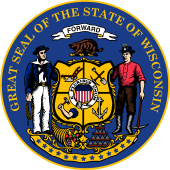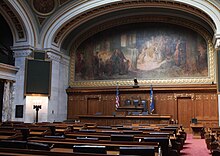Wisconsin State Assembly
Wisconsin State Assembly | |
|---|---|
| Wisconsin State Legislature | |
 | |
| Type | |
| Type | |
Term limits | None |
| History | |
New session started | January 3, 2023 |
| Leadership | |
Speaker pro tempore | |
Majority Leader | |
Minority Leader | |
| Structure | |
| Seats | 99 |
 | |
Political groups | Majority
Minority
|
Length of term | 2 years |
| Authority | Article IV, Wisconsin Constitution |
| Salary | $50,950/year + $153 per diem |
| Elections | |
Last election | November 8, 2022 |
Next election | November 5, 2024 |
| Redistricting | Legislative control |
| Meeting place | |
 | |
| State Assembly Chamber Wisconsin State Capitol Madison, Wisconsin | |
| Website | |
| Wisconsin State Assembly | |
The Wisconsin State Assembly is the lower house of the Wisconsin Legislature. Together with the smaller Wisconsin Senate, the two constitute the legislative branch of the U.S. state of Wisconsin.
Representatives are elected for two-year terms, elected during the fall elections. If a vacancy occurs in an Assembly seat between elections, it may be filled only by a special election.
The Wisconsin Constitution limits the size of the State Assembly to between 54 and 100 members inclusive. Since 1973, the state has been divided into 99 Assembly districts apportioned amongst the state based on population as determined by the decennial census, for a total of 99 representatives. From 1848 to 1853 there were 66 assembly districts; from 1854 to 1856, 82 districts; from 1857 to 1861, 97 districts; and from 1862 to 1972, 100 districts.[1] The size of the Wisconsin State Senate is tied to the size of the Assembly; it must be between one-fourth and one-third the size of the Assembly. Presently, the Senate has 33 members, with each Senate district formed by combining three neighboring Assembly districts.
The Assembly is heavily gerrymandered,[2] with a 53–45% Democratic majority in the popular vote in the 2018 election translating into a 63–36 Republican majority in the Assembly.[3][4] According to the Oshkosh Northwestern, many experts recognize Wisconsin as the most gerrymandered state in the United States,[5] a claim rated "Mostly True" by Politifact.[6] After the Republican redistricting in 2021, the Wisconsin Center for Investigative Journalism reported the efficiency gap had further increased to 16.6% in favor of Republicans.[7]
On December 22, 2023, the Wisconsin Supreme Court ruled in Clarke v. Wisconsin Elections Commission that the gerrymandered districts were unconstitutional and must be redrawn before the 2024 legislative elections.[8]
The Assembly chamber is located in the west wing of the Wisconsin State Capitol building, in Madison, Wisconsin.
History[edit]
The United States first organized Wisconsin in 1787 under the Northwest Ordinance after Great Britain yielded the land to them in the Treaty of Paris. It became the Wisconsin Territory in 1836. The then-territorial assembly, after elections, was seated in Burlington for three sessions before they relocated to the permanent capital, Madison.
During the period of territorial assembly, the assembled members helped to set up the court system, established the borders and number of counties, and regularized the spelling of Wisconsin. In 1842, an assemblyman (Charles Arndt, a Whig of Brown County) was shot dead by another assemblyman, James Vineyard, a Democrat of Grant County, over an appointment for Grant County sheriff.
Wisconsin became a U.S. state on May 29, 1848, and special elections were held to fill the first session of the State Assembly; at the time, the body consisted of 66 members.[9] The Assembly was expanded to 82 seats in 1852, and then to 97 seats in 1856, then to 100 seats in 1861, which is the maximum allowed in the Constitution of Wisconsin. The membership remained at 100 seats until the 1971 redistricting act, which decreased membership to 99 in order to comply with federal equal representation requirements within the limits of the Wisconsin Constitution. The current number of 99 seats is set in order to maintain a 3:1 ratio of Assembly to Senate seats.
On July 8, 2015, a case was filed with the U.S. District Court for the Western District of Wisconsin arguing that Wisconsin's 2011 state assembly map was unconstitutional partisan gerrymandering favoring the Republican-controlled legislature which discriminated against Democratic voters. This case became filed with the court as Whitford v Gill.[10] The case made it to the United States Supreme Court, which vacated and remanded the case. The Supreme Court held that the plaintiff challenging the state assembly map did not have standing to sue. In the Opinion of the Court, Chief Justice John Roberts stated that "[a] federal court is not 'a forum for generalized grievances," and the requirement of such a personal stake 'ensures that courts exercise power that is judicial in nature." Gill v. Whitford, 128 S.Ct. 1916 (2018). We enforce that requirement by insisting that a plaintiff [have] Article III standing..." Justice Elena Kagan filed a concurring opinion, in which Justices Ruth Bader Ginsburg, Stephen Breyer, and Sonia Sotomayor joined. Justice Clarence Thomas filed an opinion concurring in part and concurring in the judgment, in which Justice Neil Gorsuch joined.[11]
Salary and benefits[edit]

Representatives elected or re-elected in the fall of 2016 receive an annual salary of $57,408.[12]
In addition to their salaries, representatives are allowed to claim a per diem for travel expenses. The maximum rate is set by the 2001 Wisconsin Act 16 to 90% of the U.S. General Services Administration rate, but the houses are permitted to establish additional criteria for determining per diem. The State Assembly per diem is set to $155.70 per overnight stay and $77.85 for day visits. A maximum of 153 days may be claimed for per diem in 2023, and 80 days may be claimed in 2024. Over two years, each representative is allotted $12,000 to cover general office expenses, printing, postage and district mailings.
According to a 1960 study, at that time Assembly salaries and benefits were so low that in Milwaukee County, positions on the County Board of Supervisors and the Milwaukee Common Council were considered more desirable than seats in the Assembly, and an average of 23% of Milwaukee legislators did not seek re-election. This pattern was not seen to hold to the same extent in the rest of the state, where local offices tended to pay less well.[13]
Current session[edit]
Composition[edit]
| ↓ | |
| 35 | 64 |
| Democratic | Republican |
| Affiliation | Party (Shading indicates majority caucus)
|
Vacant | ||
|---|---|---|---|---|
| Democratic | Republican | Total | ||
| Begin of 101st legislature (2013) | 39 | 59 | 98 | 1 |
| End 101st (2014) | 60 | 99 | 0 | |
| Begin 102nd (2015) | 36 | 63 | 99 | 0 |
| End 102nd (2016) | ||||
| Begin 103rd (2017) | 35 | 64 | 99 | 0 |
| End 103rd (2018) | ||||
| Begin 104th (2019) | 36 | 63 | 99 | 0 |
| End 104th (2020) | 34 | 62 | 96 | 3 |
| Begin 105th (2021) | 38 | 60 | 98 | 1 |
| End 105th (2022) | 38 | 57 | 95 | 4 |
| Begin 106th (2023) | 35 | 64 | 99 | 0 |
| Current composition | ||||
| Latest voting share | 35.35% | 64.65% | ||
Assembly officers[edit]
| Position | Name | Party | ||
|---|---|---|---|---|
| Speaker | Robin Vos | Republican | ||
| Speaker Pro Tempore | Kevin D. Petersen | Republican | ||
| Majority Leader | Tyler August | Republican | ||
| Assistant Majority Leader | Jon Plumer | Republican | ||
| Majority Caucus Chair | Rob Summerfield | Republican | ||
| Minority Leader | Greta Neubauer | Democratic | ||
| Assistant Minority Leader | Kalan Haywood | Democratic | ||
| Minority Caucus Chair | Lisa Subeck | Democratic | ||
| Chief Clerk | Ted Blazel | |||
| Sergeant-at-Arms | Anne Tonnon Byers | |||
Members[edit]
The corresponding state senate districts are shown as a senate district is formed by nesting three assembly districts.
Committees[edit]
The following is a list of the Assembly Committees:[14]
- Review of Administrative Rules
- Aging and Long-Term Care
- Agriculture
- Assembly Organization
- Audit
- Campaigns and Elections
- Children and Families
- Colleges and Universities
- Constitution and Ethics
- Consumer Protection
- Corrections
- Criminal Justice and Public Safety
- Education
- Employment Relations
- Energy and Utilities
- Environment
- Family Law
- Finance
- Financial Institutions
- Forestry, Parks and Outdoor Recreation
- Government Accountability and Oversight
- Health
- Housing and Real Estate
- Insurance
- Jobs and the Economy
- Judiciary
- Labor and Integrated Employment
- Local Government
- Mental Health
- Public Benefit Reform
- Regulatory Licensing Reform
- Rules
- Rural Development
- Science, Technology, and Broadband
- Small Business Development
- Sporting Heritage
- State Affairs
- Substance Abuse and Prevention
- Tourism
- Transportation
- Veterans and Military Affairs
- Ways and Means
- Workforce Development
- Speaker's Task Force on Racial Disparities
- Special Committee on Trade and Supply Chain
- Subcommittee on Education and Economic Development
- Subcommittee on Law Enforcement Policies and Standards
Past composition of the Assembly[edit]
See also[edit]
References[edit]
- ^ Wisconsin Blue Book, 1991, p. 229.
- ^ New election data highlights the ongoing impact of 2011 GOP redistricting in Wisconsin, Journal Sentinel
- ^ Election Shows How Gerrymandering Is Difficult to Overcome, US News
- ^ No Contest, Isthmus
- ^ "Many experts recognize Wisconsin as the most gerrymandered state in the country". Oshkosh Northwestern. Retrieved June 6, 2023.
- ^ On whether Wisconsin is the most gerrymandered state, Politifact
- ^ DeFour, Matthew (December 7, 2022). "Wisconsin's Assembly maps are more skewed than ever — what happens in 2023?". Wisconsin Center for Investigative Journalism. Retrieved May 26, 2023.
- ^ Bosman, Julie (December 22, 2023). "Justices in Wisconsin Order New Legislative Maps". The New York Times. ISSN 0362-4331. Retrieved February 21, 2024.
- ^ "History of Dane County, Wisconsin : containing an account of its settlement, growth, development and resources, an extensive and minute sketch of its cities, towns and villages--their improvements, industries, manufactories, churches, schools and societies, its war record, biographical sketches, portraits of prominent men and early settlers : the whole preceded by a history of Wisconsin, statistics of the state, and an abstract of its laws and constitution and of the Constitution of the United States". content.wisconsinhistory.org. Retrieved May 5, 2023.
- ^ "Whitford v. Gill | Brennan Center for Justice". www.brennancenter.org. Retrieved December 30, 2016.
- ^ "Gill v. Whitford". SCOTUS blog. Retrieved February 9, 2019.
 This article incorporates text from this source, which is in the public domain.
This article incorporates text from this source, which is in the public domain.
- ^ "Salaries of Wisconsin State Elected Officials, 2023" (PDF). Wisconsin Legislative Reference Bureau. February 2023. Retrieved June 9, 2023.
- ^ Hagensick, A. Clarke (1964). "Influences of Partisanship and Incumbency on a Nonpartisan Election System". The Western Political Quarterly. 17 (1): 117–124. doi:10.2307/445376. JSTOR 445376.
- ^ docs.legis.wisconsin.gov, retrieved November 27, 2020
External links[edit]
- Wisconsin State Assembly official government website
- State Assembly of Wisconsin at Project Vote Smart
- Wisconsin State Assembly at Ballotpedia
- Legislature Salary
